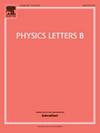三维BTZ黑洞的通用热力学拓扑类
IF 4.3
2区 物理与天体物理
Q1 ASTRONOMY & ASTROPHYSICS
引用次数: 0
摘要
我们建立了三维静态中性黑洞Bañados-Teitelboim-Zanelli (BTZ)、带电黑洞BTZ和旋转黑洞BTZ的通用热力学拓扑分类。我们证明了在所有三种情况下(静态中性BTZ、带电BTZ和旋转BTZ黑洞),最内层的小黑洞态和最外层的大黑洞态都表现出稳定的热力学行为。在低温极限下,这三种情况都表现出热力学稳定的小黑洞状态。相反,在高温极限下,每个系统都承认一个热力学稳定的大黑洞状态。通过这一分析,我们严格地证明了静态中性黑洞、带电黑洞和旋转BTZ黑洞始终被归为W1+类。我们的研究结果表明,电荷参数和旋转参数对三维静态中性BTZ黑洞的普遍热力学拓扑分类都没有显著影响。这揭示了一个基本的二分法:虽然角动量和电荷在四维静态黑洞的热力学拓扑中占主导地位,但在三维静态BTZ情况下,它们的影响可以忽略不计,突出了黑洞热力学行为的维度驱动分歧。本文章由计算机程序翻译,如有差异,请以英文原文为准。
Universal thermodynamic topological classes of three-dimensional BTZ black holes
We establish a universal thermodynamic topological classification for three-dimensional static neutral Bañados-Teitelboim-Zanelli (BTZ), charged BTZ, and rotating BTZ black holes. We demonstrate that in all three cases (static neutral BTZ, charged BTZ, and rotating BTZ black holes), both the innermost small black hole states and the outermost large black hole states exhibit stable thermodynamic behavior. In the low-temperature limit, all three cases exhibit a thermodynamically stable small black hole state. Conversely, in the high-temperature limit, each system admits a thermodynamically stable large black hole state. Through this analysis, we have rigorously shown that static neutral, charged, and rotating BTZ black holes are consistently classified within the category. Our results demonstrate that neither the charge parameter nor the rotation parameter exerts significant influence on the universal thermodynamic topological classification of three-dimensional static neutral BTZ black holes. This reveals a fundamental dichotomy: while angular momentum and electric charge dominate the thermodynamic topology of four-dimensional static black holes, their effects become negligible in the three-dimensional static BTZ case, highlighting a dimension-driven divergence in black hole thermodynamic behavior.
求助全文
通过发布文献求助,成功后即可免费获取论文全文。
去求助
来源期刊

Physics Letters B
物理-物理:综合
CiteScore
9.10
自引率
6.80%
发文量
647
审稿时长
3 months
期刊介绍:
Physics Letters B ensures the rapid publication of important new results in particle physics, nuclear physics and cosmology. Specialized editors are responsible for contributions in experimental nuclear physics, theoretical nuclear physics, experimental high-energy physics, theoretical high-energy physics, and astrophysics.
 求助内容:
求助内容: 应助结果提醒方式:
应助结果提醒方式:


